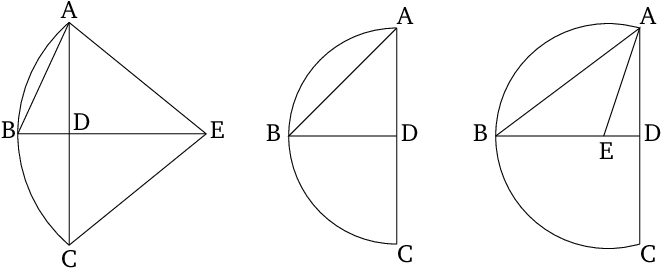Proof: By Euclid
(related to Proposition: 3.25: Construction of Circle from Segment)

- Thus, angle $ABD$ is surely either greater than, equal to, or less than (angle) $BAD$.
- First of all, let it be greater.
- And Let (angle) $BAE$, equal to angle $ABD$, have been constructed on the straight line $BA$, at the point $A$ on it [Prop. 1.23].
- And let $DB$ have been drawn through to $E$, and let $EC$ have been joined.
- Therefore, since angle $ABE$ is equal to $BAE$, the straight line $EB$ is thus also equal to $EA$ [Prop. 1.6].
- And since $AD$ is equal to $DC$, and $DE$ (is) common, the two (straight lines) $AD$, $DE$ are equal to the two (straight lines) $CD$, $DE$, respectively.
- And angle $ADE$ is equal to angle $CDE$.
- For each (is) a right angle.
- Thus, the base $AE$ is equal to the base $CE$ [Prop. 1.4].
- But, $AE$ was shown (to be) equal to $BE$.
- Thus, $BE$ is also equal to $CE$.
- Thus, the three (straight lines) $AE$, $EB$, and $EC$ are equal to one another.
- Thus, if a circle is drawn with center $E$, and radius one of $AE$, $EB$, or $EC$, it will also go through the remaining points (of the segment), and the (associated circle) will have been completed [Prop. 3.9].
- Thus, a circle has been completed from the given segment of a circle.
- And (it is) clear that the segment $ABC$ is less than a semicircle, because the center $E$ happens to lie outside it.
- And, similarly, even if angle $ABD$ is equal to $BAD$,
- And if $ABD$ is less than $BAD$,
- (Which is) the very thing it was required to do.
∎
Thank you to the contributors under CC BY-SA 4.0! 

- Github:
-

- non-Github:
- @Fitzpatrick
References
Adapted from (subject to copyright, with kind permission)
- Fitzpatrick, Richard: Euclid's "Elements of Geometry"
